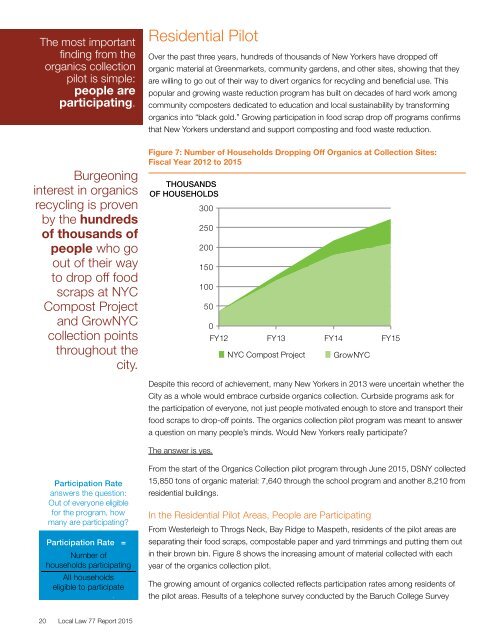2015 NYC Organics Collection Report
1jcwPY1
1jcwPY1
Create successful ePaper yourself
Turn your PDF publications into a flip-book with our unique Google optimized e-Paper software.
The most important<br />
Residential Pilot<br />
Capture Rate answers the question:<br />
Of all finding the food from scraps, the yard trimmings Over the and past compostable three years, hundreds paper of thousands of New Yorkers have dropped off<br />
that could be recycled, how much is actually being recycled?<br />
organics collection organic material at Greenmarkets, community gardens, and other sites, showing that they<br />
pilot is simple: Quantity are willing of organics to go out collected<br />
Capture Rate =<br />
of their way to divert organics for recycling and beneficial use. This<br />
people are Quantity popular of organics and generated growing waste waste reduction program has built on decades of hard work among<br />
participating. community composters dedicated to education and local sustainability by transforming<br />
organics into “black gold.” Growing participation in food scrap drop off programs confirms<br />
that New Yorkers understand and support composting and food waste reduction.<br />
Participation Rate answers the question: Out of everyone<br />
eligible for the program,<br />
Figure<br />
how many<br />
7: Number<br />
are participating?<br />
of Households Dropping Off <strong>Organics</strong> at <strong>Collection</strong> Sites:<br />
Fiscal Year 2012 to <strong>2015</strong><br />
Participation Burgeoning<br />
Rate =<br />
Number of households participating<br />
All households THOUSANDS eligible to participate<br />
OF HOUSEHOLDS<br />
interest in organics<br />
recycling is proven<br />
by the hundreds<br />
of thousands of<br />
people who go<br />
200<br />
Diversion Rate answers the question: How much of everything<br />
we throw out is kept from disposal 150 and put to good use?<br />
out of their way<br />
to drop off food<br />
Diversion scraps Rate at = <strong>NYC</strong><br />
Compost Project<br />
and Grow<strong>NYC</strong><br />
collection points<br />
throughout the<br />
city.<br />
300<br />
250<br />
Quantity of recycling<br />
100<br />
(organics, paper, metal, glass and plastic collected)<br />
Quantity of all 50waste collected<br />
0<br />
Despite this record of achievement, many New Yorkers in 2013 were uncertain whether the<br />
Per Household Rate City answers as a whole the question: would embrace What is curbside each organics collection. Curbside programs ask for<br />
eligible household's share (on average) of organics recycling?<br />
the participation of everyone, not just people motivated enough to store and transport their<br />
food scraps Quantity to drop-off of organics points. collected<br />
Per Household Rate =<br />
The organics collection pilot program was meant to answer<br />
Number a question of households on many people’s eligible minds. to participate Would New Yorkers really participate?<br />
The answer is yes.<br />
FY12 FY13 FY14 FY15<br />
<strong>NYC</strong> Compost Project<br />
Grow<strong>NYC</strong><br />
Participation Rate<br />
answers the question:<br />
Out of everyone eligible<br />
for the program, how<br />
many are participating?<br />
Participation Rate =<br />
Number of<br />
households participating<br />
All households<br />
eligible to participate<br />
From the start of the <strong>Organics</strong> <strong>Collection</strong> pilot program through June <strong>2015</strong>, DSNY collected<br />
15,850 tons of organic material: 7,640 through the school program and another 8,210 from<br />
Capture Rate answers<br />
residential<br />
the question:<br />
buildings.<br />
Of all the food scraps,<br />
yard trimmings and compostable<br />
In the paper Residential that could be Pilot recycled, Areas, how People are Participating<br />
much is actually being recycled?<br />
From Westerleigh to Throgs Neck, Bay Ridge to Maspeth, residents of the pilot areas are<br />
separating their Capture food Rate scraps, = compostable paper and yard trimmings and putting them out<br />
in their brown bin. Quantity Figure of8 shows the increasing amount of material collected with each<br />
year of the organics collection collected pilot.<br />
Quantity of organics<br />
The growing generated amount of as organics waste collected reflects participation rates among residents of<br />
the pilot areas. Results of a telephone survey conducted by the Baruch College Survey<br />
20 Local Law 77 <strong>Report</strong> <strong>2015</strong>


